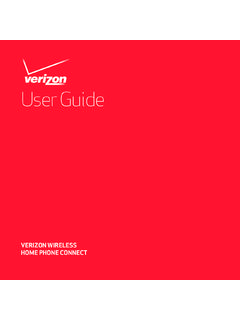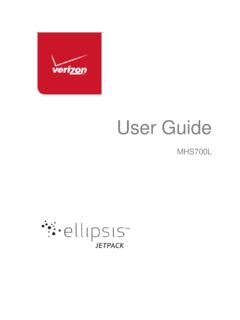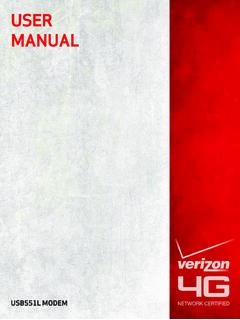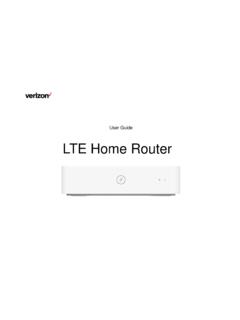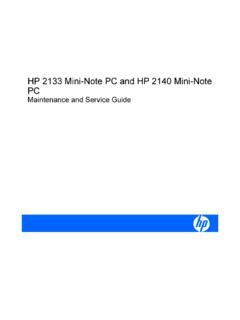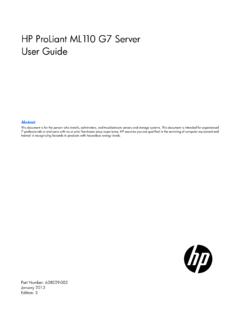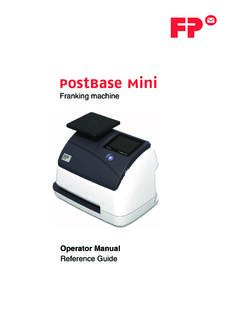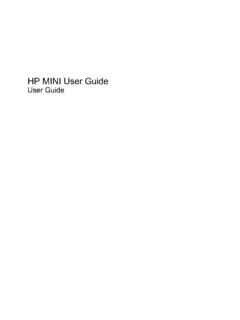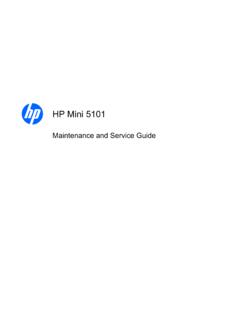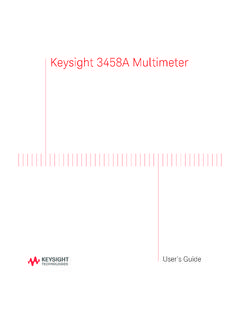Transcription of Contents
1 Getting Started GuideiiiContentsChapter 1: Getting to know your computerTop .. 1 TouchPad .. 1 Lights .. 2 Keys .. 3 Front .. 4 Right side .. 5 Left side .. 7 Display .. 9 Bottom .. 10 Keyboard and pointing devices .. 11 Using the keyboard .. 11 Setting pointing device preferences .. 13 Using pointing devices .. 13 Chapter 2: Welcome to Verizon WirelessThank you for choosing Verizon Wireless .. 15 Mobile Broadband setup .. 15 Verizon Wi-Fi .. 18 Upgrade VZAccess Manager software .. 19 Finding Verizon Wireless help in the .. 19 Global access outside of the and Canada .. 20 Removing or inserting a global SIM Card .. 21 Using VZAccess Manager outside of the and Canada .. 23 GPS functionality .. 23 Verizon Wireless network technology .. 23 VZAccess Manager user tips .. 24 Windows automatic updates.
2 24 Loss or theft .. 25 Fraud prevention .. 25My Verizon .. 26 Chapter 3: Upgrading and routine careInserting or removing the battery .. 27 Replacing or upgrading the hard drive .. 28 Removing the hard drive .. 28 Installing a hard drive .. 30 Adding or replacing memory modules .. 32 Updating programs and drivers .. 36 Cleaning the display .. 36 Cleaning the TouchPad and keyboard .. 36 Traveling and shipping .. Page iii Tuesday, August 3, 2010 4:11 PMivGetting Started GuideContentsChapter 4: TroubleshootingContacting customer support .. 39 Identifying the labels .. 39 Troubleshooting resources .. 40 Quick troubleshooting .. 41 The computer is unable to start up .. 41 The computer screen is blank .. 41 Software is functioning abnormally .. 41 The computer is on but is not responding.. 41 The computer is unusually warm.
3 42 The wireless network connection is not working .. 42 Chapter 5: Backup and recoveryRecovery discs .. 43 Performing a recovery .. 44 Recovering using the partition on the hard drive (select models only) .. 44 Recovering using the recovery discs .. 45 Backing up your information .. 45 Using Windows Backup and Restore .. 45 Using system restore points .. 46 Chapter 6: Important consumer informationSecurity deposit .. 47 FCC rules and regulations .. 47 National Do Not Call Registry .. 47 Radio emission safety .. 48 Are wireless phones and devices safe? .. 48 What does specific absorption rate (SAR) mean? .. 48 Can I minimize my RF exposure while using my phone or device? .. 49Do wireless phones pose any special threat to children? .. 49 Where can I get further information about RF emissions? .. 49 Implantable medical devices.
4 50 Drive responsibly .. 50 Chapter 7: SpecificationsOperating environment .. 51 Input power .. Page iv Tuesday, August 3, 2010 4:11 PMGetting Started Guide1 Chapter 1: Getting to know your computerAfter you set up and register the computer, it is important to learn about your computer the pointer and selects or activates items on the TouchPad buttonFunctions like the left button on an external TouchPad buttonFunctions like the right button on an external table describes factory settings. To view or change pointing device preferences, select Start > Devices and Page 1 Tuesday, August 3, 2010 4:11 PM2 Getting Started GuideChapter 1: Getting to know your computerLightsComponentDescription1 Caps lock lightOn: Caps lock is light Amber: Computer sound is off. Off: Computer sound is light White: An integrated wireless device, such as a wireless local area network (WLAN) device and/or a Bluetooth device, is on.
5 Amber: All wireless devices are Page 2 Tuesday, August 3, 2010 4:11 PMGetting Started Guide3 Chapter 1: Getting to know your computerKeysComponentDescription1esc keyDisplays system information when pressed in combination with the fn keyExecutes frequently used system functions when pressed in combination with an arrow key or the esc logo keyDisplays the Windows Start applications keyDisplays a shortcut menu for items beneath the keysScroll the page up or down, or when pressed in combination with the fn key, move to the beginning or end of the keysExecute frequently used system Page 3 Tuesday, August 3, 2010 4:11 PM4 Getting Started GuideChapter 1: Getting to know your computerFrontComponentDescription1 Vents (2)Enable airflow to cool internal components. The computer fan starts up automatically to cool internal components and prevent overheating.
6 It is normal for the internal fan to cycle on and off during routine Page 4 Tuesday, August 3, 2010 4:11 PMGetting Started Guide5 Chapter 1: Getting to know your computerRight sideComponentDescription1 Digital Media SlotSupports the following optional digital card formats: MultiMediaCard (MMC) Secure Digital (SD) Memory Card Secure Digital Extended Capacity (SDxC) Memory Card Secure Digital High Capacity (SDHC) Memory Card2 Power light White: The computer is on. Blinking white: The computer is in the Sleep state. Off: The computer is off or in switch When the computer is off, slide the switch to turn on the computer. When the computer is on, slide the switch briefly to initiate Sleep. When the computer is in the Sleep state, slide the switch briefly to exit Sleep. When the computer is in Hibernation, slide the switch briefly to exit the computer has stopped responding and Windows shutdown procedures are ineffective, slide and hold the power switch for at least 5 seconds to turn off the learn more about your power settings, select Start > Control Panel > System andSecurity > Power Options.
7 (Continued) Page 5 Tuesday, August 3, 2010 4:11 PM6 Getting Started GuideChapter 1: Getting to know your computer4 USB ports (2)Connect optional USB (network) jackConnects a network cable slotAttaches an optional security cable to the computer. The security cable is designed to act as a deterrent, but it may not prevent the computer from being mishandled or Page 6 Tuesday, August 3, 2010 4:11 PMGetting Started Guide7 Chapter 1: Getting to know your computerLeft sideComponentDescription1 Power connectorConnects an AC adapter light White: The computer is connected to external power and the battery is fully charged. Amber: The computer is connected to external power and the battery is charging. Off: The computer is not connected to external monitor portConnects an external VGA monitor or airflow to cool internal components.
8 The computer fan starts up automatically to cool internal components and prevent overheating. It is normal for the internal fan to cycle on and off during routine operation.(Continued) Page 7 Tuesday, August 3, 2010 4:11 PM8 Getting Started GuideChapter 1: Getting to know your computer5 Drive lightBlinking: The hard drive or flash drive is being portConnects an optional USB (headphone) jack/Audio-in (microphone) jackConnects optional powered stereo speakers, headphones, earbuds, a headset, or television audio. Also connects an optional headset microphone. WARNING: To reduce the risk of personal injury, adjust the volume before putting on headphones, earbuds, or a headset. For additional safety information, refer to the Regulatory, Safety, and Environmental Notices. When a device is connected to the jack, the computer speakers are Page 8 Tuesday, August 3, 2010 4:11 PMGetting Started Guide9 Chapter 1: Getting to know your computerDisplayComponentDescription1 WWAN antennas (2)*Send and receive wireless signals to communicate with wireless wide-area networks (WWANs).
9 2 WLAN antennas (2)*Send and receive wireless signals to communicate with wireless local-area networks (WLANs).3 Webcam lightOn: The webcam is in video and captures still use the webcam, select Start > All Programs > HP > HP Media Suite > HP microphoneRecords sound.*The antennas are not visible from the outside of the computer. For optimal transmission, keep the area immediately around the antennas free from obstructions. To see wireless regulatory notices, refer to the section of the Regulatory, Safety, and Environmental Notices that applies to your country or region. These notices are located in Help and Page 9 Tuesday, August 3, 2010 4:11 PM10 Getting Started GuideChapter 1: Getting to know your computerBottomComponentDescription1 Battery release latches (2)Release the battery from the battery bayHolds the Page 10 Tuesday, August 3, 2010 4:11 PMGetting Started Guide11 Chapter 1: Getting to know your computerUsing the keyboardUsing the action keysAction keys are customized actions that are assigned to specific keys at the top of the keyboard.
10 The icons on the f1 through f12 keys represent the action key functions. To use an action key, press and hold the key to activate the assigned function. The action key feature is enabled at the factory. You can disable this feature in Setup Utility. If this feature is disabled in Setup Utility, you must press fn and an action key to activate the assigned and pointing devicesKeyDescriptionf1 Opens Help and and Support provides tutorials, answers to questions, and product the screen brightness the screen brightness the screen image among display devices connected to the system. For example, if a monitor is connected to the computer, pressing this key alternates the screen image from computer display to monitor display to simultaneous display on both the computer and the external monitors receive video information from the computer using the external VGA video standard.

